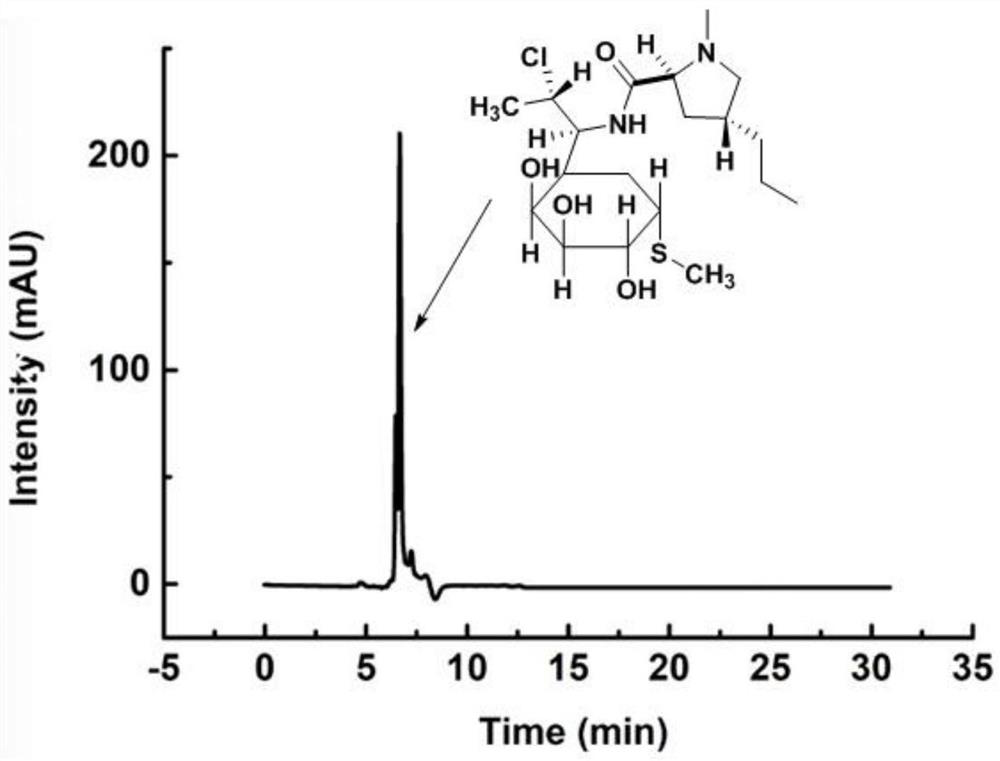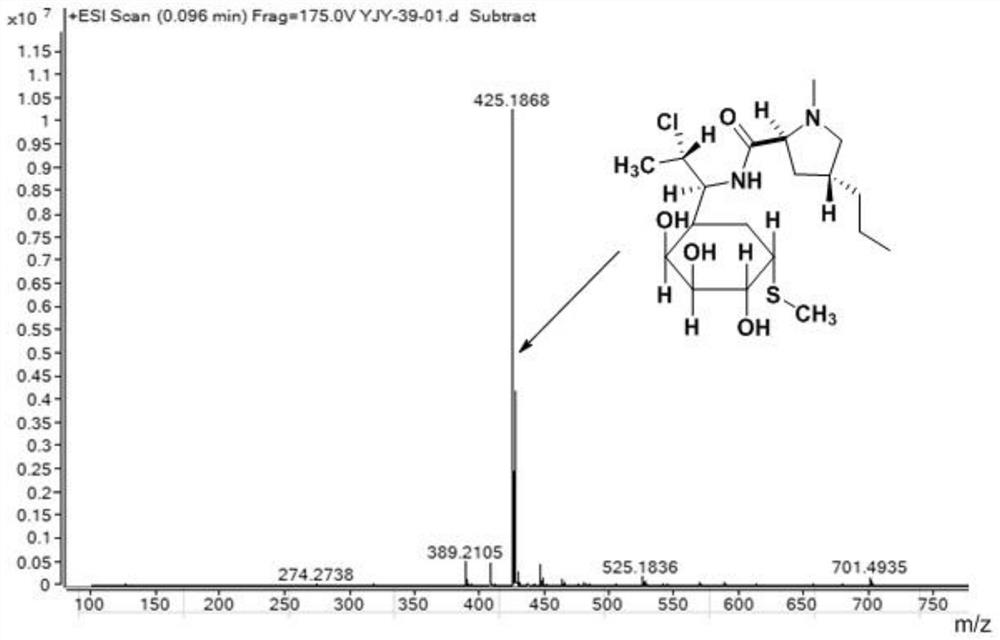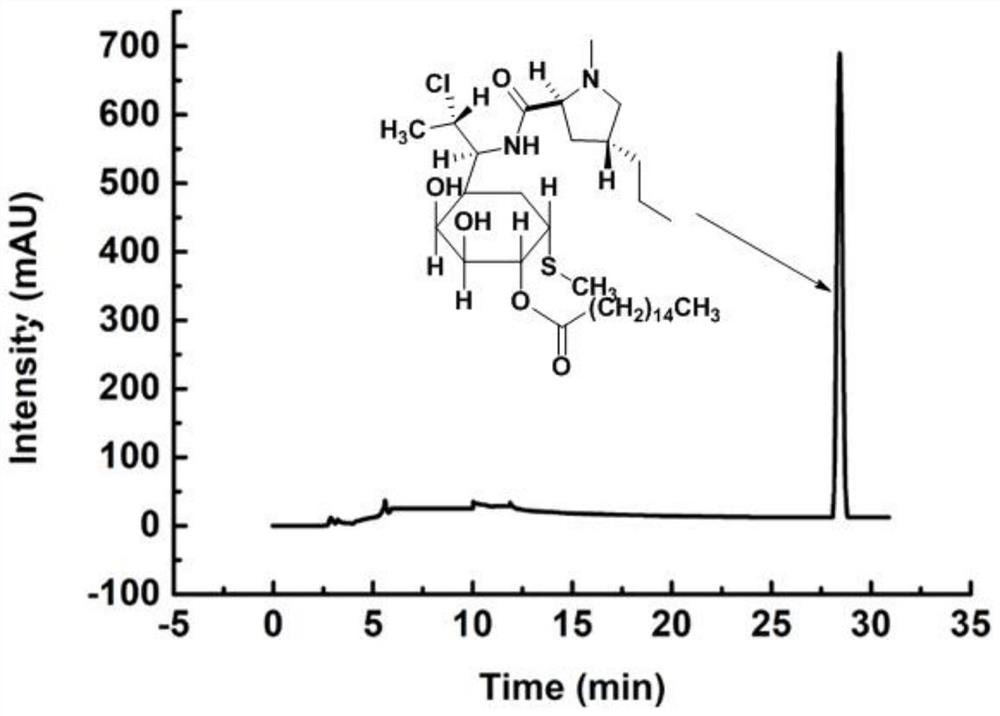A lipase-calcium phosphate complex enzyme crystal, its preparation method and its catalytic method for synthesizing clindamycin palmitate
A technology for synthesizing clindamycin and palmitate, applied in biochemical equipment and methods, enzymes, enzymes, etc., can solve the problems of resin becoming solid waste, not meeting sustainable development, and reducing enzyme activity, and improving production. Safety, high yield, effect of reducing steps
- Summary
- Abstract
- Description
- Claims
- Application Information
AI Technical Summary
Problems solved by technology
Method used
Image
Examples
Embodiment 1
[0055] Example 1: Preparation of clindamycin free base:
[0056] Dissolve 2.5g of clindamycin hydrochloride in 6mL of deionized water, mix well, slowly add 6mL of NaOH (1mol / L) and keep stirring, then let it stand for a while, remove the upper layer of water, the lower layer of precipitation at 45 °C in a vacuum oven for one day; the obtained white solid is clindamycin free base.
[0057] Such as figure 1 As shown, the clindamycin free base HPLC analysis spectrum that embodiment 1 prepares; Get the clindamycin free base of 1mg in 1mL methanol, mix with the organic phase membrane filter of 0.22 μ m aperture, Obtain the sample, the following sample preparation process is the same; HPLC conditions: C18 column, column temperature 25 ℃, 226nm, 0.5mL / min, mobile phase: methanol: 3% ammonium acetate = 70:30, clindamycin free The alkali retention time is 6.23min.
[0058] Such as figure 2 As shown, the LC-MS spectrum of clindamycin free base prepared in Example 1: (m / z, 425.2)....
Embodiment 2
[0059] Example 2: Preparation of calcium phosphatase crystals:
[0060] 100 μL of calcium chloride solution (200 mM) was added to 5 mL of phosphate buffered saline (PBS, 20 mM, pH 6.7) containing 0.25 mg / ml Thermomyces lanuginosus lipase (TLL), and the mixture was heated at 4°C Cultivate under the conditions for 24 hours; then centrifuge at 10,000 rpm for 5 minutes, remove the supernatant to obtain a white precipitate; finally wash the obtained precipitate three times with deionized water to obtain the calciphosphatase crystal of Thermomyces lanuginosus lipase.
Embodiment 3-1
[0063] Example 3-1: Preparation of clindamycin palmitate:
[0064] Weigh 13.25mg (0.3125mmol) of clindamycin free base and 26.48mg (0.9375mmol) of vinyl palmitate and add it to a centrifuge tube with 6.25mL of petroleum ether, and add calcium phosphate crystals (containing 150mg of hydrophobic Cottonophilus lipase) was shaken in a shaker at a speed of 200 rpm for 24 hours at 30°C; after the reaction, centrifuged, and the filter residue was washed with the washing solvent petroleum ether to obtain the supernatant; Heat and spin dry the supernatant under reduced pressure, add dichloromethane to dissolve and adjust the pH value to 1-2 with dilute hydrochloric acid, then heat and spin dry the solvent under reduced pressure, add ethanol to dissolve and add acetonitrile, stir at 0°C for 4 hours, and finally Cold filtration and drying to obtain a white solid, the white solid is clindamycin palmitate.
[0065] Such as image 3 As shown, the HPLC analysis spectrum of clindamycin pa...
PUM
 Login to View More
Login to View More Abstract
Description
Claims
Application Information
 Login to View More
Login to View More - R&D Engineer
- R&D Manager
- IP Professional
- Industry Leading Data Capabilities
- Powerful AI technology
- Patent DNA Extraction
Browse by: Latest US Patents, China's latest patents, Technical Efficacy Thesaurus, Application Domain, Technology Topic, Popular Technical Reports.
© 2024 PatSnap. All rights reserved.Legal|Privacy policy|Modern Slavery Act Transparency Statement|Sitemap|About US| Contact US: help@patsnap.com










